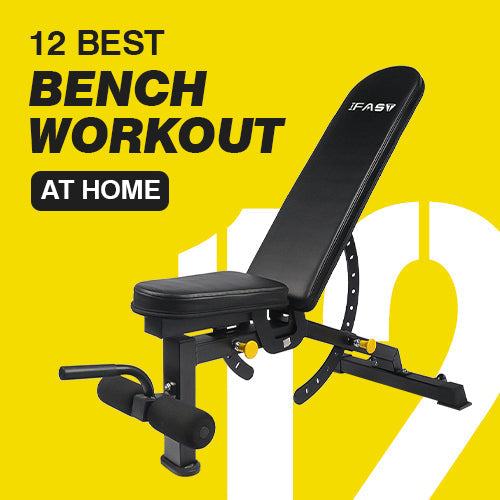
Chest exercise is an itinerary that most bodybuilders will incorporate in their later fitness careers, mainly focusing on the bench press.
The incline dumbbell press should be the one you need most for the bench press exercises. One reason is that the upper chest is often the weakest part of the pectoral muscle. The other reason is that the incline dumbbell bench press is easier to feel and stimulates better than the incline barbell bench press (although the weight is lighter than the barbell )
What is the incline dumbbell press?
The incline dumbbell press, also known as the incline chest press and incline dumbbell bench press, is an upper body exercise that works the pecs in your chest, the triceps in the back of your arms, the deltoids in the front to tuck your shoulders. The angle of the adjustable bench press in this variant puts more pressure on your upper chest muscles than the flat bench press.
Benefits Of Dumbbell Press
1.The dumbbell bench press has vital freedom, and the exercise is more comprehensive
The dumbbell bench press has a lot of freedom, and you can try bench presses in different directions to train other parts. The pressure on the shoulders of the dumbbell bench press is much less than that of the barbell bench press. The less the strength of the deltoid is, the stronger the stimulation of the chest. The landing point of a dumbbell bench press can be much lower than that of a barbell bench press, which can lengthen the movement trajectory and exercise more comprehensively.
2.The range of dumbbell bench press is not limited, and it is easier to grasp
When you do the barbell bench press, the forearm can only move up and down, the lateral movement will be limited, and the chest muscles will not be fully trained. On the contrary, when doing bench press with dumbbells, because the hands can move up and down and laterally, the range of motion will not be limited, and the "shoulder horizontal adduction" can be carried out at the full range because this exercise method is not restricted, so it is easier to master, easier to grasp.
3.The dumbbell bench press works better for the shoulders and chest
Using a dumbbell bench press to exercise the chest is very obvious. First, lie on your back on a stool or bed, and use dumbbells to do flat bench presses. You can also use dumbbells to do bird exercises at many angles, which can develop the muscles of other parts of the sternum. The movement of the shoulder muscles is also significant. Holding dumbbells in both hands, the evaluator, the front raise, and the bent-over bird exercise, these can be practiced to the middle, front and rear of the deltoid muscles of the shoulders, and can also be practiced to Trapezius, overhead with dumbbells, and shrugs can also work the shoulder muscles. Using a dumbbell bench press can specifically exercise the powers in the body; you can exercise the forearm, and you can also exercise the thigh. Using dumbbell bench press to exercise abdominal muscles is pronounced, but you must persevere when practicing and stick to one exercise every day. After hours of dumbbell bench press, you can see results in a month.
Incline Dumbbell Press Muscles Worked

Type: Strength
Level: Intermediate
Primary Muscle Groups: chest
Other muscles: Triceps, shoulders
Equipment requirements: Dumbbells and weight bench
Incline Dumbbell Press: How to, Angle, Weight And Groups, Common Mistakes, Variations
How to do incline dumbbell press
- Sit on an incline bench with a dumbbell in each hand, resting on your thighs, palms facing each other.
- Then, lift the dumbbells with your thighs, one at a time, and place them in front of your chest, palms forward, shoulder-width apart. At the same time, lie back on the backrest, chest and abdomen. This is where the action starts.
- Then, use the strength of the chest to press the dumbbells up while exhaling. Remember to maintain control of the dumbbells throughout the process and keep the chest and abdomen.
- Straighten your arms naturally, stop when you reach the top, start to descend slowly, and breathe in when dropping. Ideally, the descent should take twice as long as the lift.
- The above is a complete action; repeat the step up to the recommended number of times.
- When you're done training, return the dumbbells to your legs and the floor. This is how the dumbbells are placed safely.
Incline dumbbell press angle
If you do a 0-degree chest press on a flat bench, your mid-chest will carry all the weight. The 45-degree incline will work your upper chest muscles, but your delts will also play a significant role.
However, a 30-degree incline is best for effectively working the upper chest muscles while minimizing the effect of the front delts or shoulders.
Therefore, between 30 and 45 degrees, the 30-degree angle is best for primarily activating your upper chest muscles.
Weight And Groups
The weight of the incline dumbbell bench press is generally lighter than that of the flat bench press. According to the number of times per set, it is typically 8-12RM weight, and it looks like 4-5 sets (of course, you can also choose multiple times, such as four sets. This is 20 times per set, it is also very tiring, but the effect of muscle building is not so good)
Common Mistakes
Too Much Weight
When training with heavyweights, both the chest muscles and the deltoid and triceps will participate in the training. The more muscle groups involved, there is no way to ensure that the upper part of the chest muscles is the main force during movement. The recruitment effect is too noticeable.
Training range
When doing related training, I did not master the best training range. When measuring whether the training action is standard, a critical condition is whether the movement range is sufficient. Not all training movements are better trained, and the effect will be better.
Specifically, it depends on the action, the purpose, and the target muscle of the training. Sometimes, too much training range will affect the fitness action itself and even change the main force-generating parts.
Hunchback
Posture is essential in the preparation stage of almost all training movements. However, many bodybuilders disagree with this. Take today's incline dumbbell bench press, for example. Due to personal habits, many bodybuilders, if it leads to posture errors, if we practice without adjustment during formal training, will allow us to complete the entire exercise in a state of hunchback. What impact will it bring to us? First of all, the sense of strength in the upper chest will be fragile, and the posture problem will be more serious.
Therefore, when we are training, we need to ensure that the chest and shoulders are lifted to adjust the training movements so that the shoulders are as far back as possible. The shoulders are as far back as possible to avoid the situation of the shoulders being buckled inward and the shoulders shrugging so as to activate the upper body as much as possible. Chest, minimize deltoid involvement as much as possible.
Elbow openness
When performing traditional bench press training, the angle between the arm and the body is about 45 degrees. Don't make the angle between the arm and the body too large; otherwise, the shoulders will bear a lot of unnecessary pressure, causing shoulder pain. Depending on the situation, during the incline bench press training, the degree and angle of walking and opening can be adjusted appropriately.
It is recommended that you ensure that the angle between the arm and the body is about 60 degrees. According to the flexibility of the shoulders, the tip can be appropriately increased or decreased. But don't increase the angle too much, don't exceed 80 degrees.
Incline Dumbbell Press Variations
Decline dumbbell bench press

1, is an excellent way to train the lower chest muscles; the head is lower than the torso, the torso is at a 15-25 degree angle to the ground
2.At the same time, it also has an excellent stimulating effect on the triceps and anterior deltoid muscles.
Rotational dumbbell bench press

1.Adding the factor of rotation to the traditional bench press process can train the large muscles on the surface and strengthen the stabilizing muscles in the deep shoulders (shoulder rotator cuff) to make your shoulders stronger.
2.External rotation of the shoulders when falling will help stabilize your shoulders, and adding internal processes when pushing up will help the chest muscles better participate in the exertion.
Alternating Dumbbell Bench Press

1.It is a movement that trains the strength of one arm and builds the stability of the shoulder and core.
2.During the action, it can increase the time the muscles are under tension and increase the stimulation of the pectoral muscles.
Single-arm dumbbell bench press

1.Unilateral stimulation, anti-rotation core strength training, because the offset of the load makes the whole body need more stability.
2.Your shoulders will be protected during the movement because, in the lowering stage, the impact on the shoulders will be eliminated.


